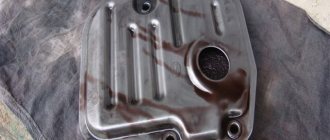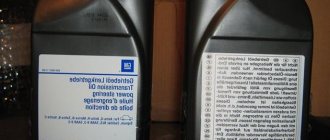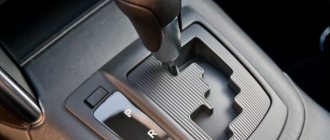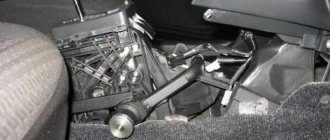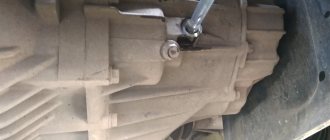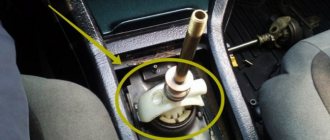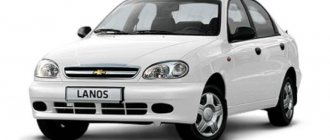I am often asked what this button on an automatic transmission is called “Shift Lock”. What is it for? Therefore, today we will look at what this key means on the machine and how to use it.
Write in the comments, have you already tried pressing this key, have you heard any changes in the sound of the running engine or automatic transmission?
Purpose of the Shift Lock button on an automatic transmission
Few drivers can give exactly what “Shiftlock” is needed on an automatic transmission. I know car owners who generally pay attention to additional buttons on automatic transmissions. Well, there are those who often press it, but do not receive a response.
Read
Which gearbox is more reliable and better: robot, CVT or automatic?
First, let's figure out where it is. It can be found on the automatic transmission selector, to the left of the gear lever. You will read its full name “Shift Lock Release” in an automatic transmission operating book, but you will never be able to understand what it is for. Because this information is not written in the book.
If you haven’t pressed it yet, I’ll tell you what those who had already experimented with this key expected and... nothing has changed:
- no additional sounds were added;
- the display on the dashboard monitor has not changed;
- the engine and automatic transmission are operating normally;
- the key does not have a lock. Therefore, it cannot be drowned.
“What is really happening and why is it needed then?” - you ask. The fact is that the automatic transmission is equipped with a gear shift lock when the engine is not running. For example, the car owner will not be able to switch the gear shift from the “Parking” position to the “Forward” mode until he turns on the ignition.
Read
The design and principle of operation of the automatic transmission torque converter
However, by holding ShiftLock, you can move the gear selector lever to any position necessary for transporting a faulty machine. This is the purpose of “Shift lock”.
Attention! I do not recommend using it in situations where the automatic transmission is alive and working normally. Since the button is designed for experienced mechanics who repair cars, for transporting a car from one place to another.
What's new?
The automatic transmission of the Hyundai Creta has six gears. In essence, this is a classic automatic transmission, differing from its 4- and 5-speed predecessors in a small number of design features. The developer was the Hyundai company itself. Assembly is also carried out at the plant of the Korean manufacturer.
When compared with previous types of transmissions, the A6GF1/A6MF2 series is positioned by the manufacturer as maintenance-free. There is no dipstick for monitoring the oil level in the automatic transmission, and there is no need to change the working fluid in the gearbox. According to the manufacturer, the oil life is sufficient for the entire period of operation.
But there were changes. The advantages of the A6GF1/A6MF2 Hyundai Creta automatic transmission include:
- Greater work resource.
- Active dynamics of acceleration, comparable in characteristics to “mechanics”.
- Lower fuel consumption.
The innovations discussed are easy to explain. The developers have introduced an advanced torque converter locking algorithm, which is usually used in gearboxes with an electronic control system. As a result, the torque converter is switched off, and the chassis mechanics and the engine are integrated with each other without an “intermediary”. It turns out that the most energy-consuming node is excluded from the system, without which A6GF1/A6MF2 becomes more efficient.
But that's not all. Automatic shutdown of the torque converter occurs in other cases. One of them is the Hyundai Creta stopping for a long time at an intersection when the gear shift knob is in the “Drive” position.
An example of a Hyundai Creta automatic transmission.
List of situational moments that require turning on the button
However, if the automatic transmission has gone into emergency mode or the engine has stalled in the middle of a busy highway, you can safely use Shift Lock to, for example, set the rocker to the neutral position. It will be easier for another car to tow your box without harm if there is no tow truck nearby.
Read
What is the difference and how does a robotic gearbox differ from an automatic gearbox?
Now I will describe situations in which the use of “Shift Lock” on an automatic transmission will be useful to you:
- stopping at a gas station;
- car breakdown requiring towing, as I wrote above;
- stopping in front of the turnstile to deposit money.
Thanks to this key, you can always unlock the automatic transmission and put the rocker in the desired position. By the way, on old boxes, instead of a key, the driver found a hole for the key. The key acted as a “Shift Lock” unlocker, by inserting which it was also possible to change the position of the selector lever on a locked automatic transmission.
Other problems and repair parts
When operating the Hyundai Creta automatic transmission, it is worth considering the following:
- The use of a repair kit for oil seals and gaskets may be required if leaks occur and Teflon rings are worn out. After 100,000 kilometers, it is worth changing the gaskets and rings of the hydraulic unit.
- Low oil pressure increases the risk of failure of the most heavily loaded front clutch pack. If nothing is done, the solenoids and valves of the automatic transmission hydraulic unit break.
- On the A6MF1/2 automatic transmission, the clutch often burns out, so it is important to install reinforced clutches equipped with special steel thrust discs.
- During active use, the torque converter clutch quickly fails. At the same time, the more active the acceleration, the faster the overhaul of the automatic transmission is required. If you delay this process, the problem manifests itself as vibrations and excessive heating of the hub, after which the pump bushings and seal fail.
However, as can be seen from the reviews of Hyundai Creta owners, such problems arise quite rarely.
This is what Creta solenoids look like.
How to use "Shift lock"
In order for the button to have the desired effect, you must take the following steps:
- Click on it.
- Do not release until you have moved the shift lever to the “N” position if you need to tow the vehicle with another vehicle.
- Release the button on the machine.
- Then you can push the car or transport it on a trailer.
Read
What is the difference between rights to an automatic and rights to a manual?
Now you know how and where to use this key. It may look different on different brands of vehicles.
For example:
- on Toyota cars you will find it slightly recessed into the selector. And it will be called not just Shift Lock, but “Shift Lock Release”;
- on Kia the switch will be hidden under a special panel. The lid must be opened to use the “Shift lock”;
- There are no identification marks on the Ford Focus and other modifications of vehicles that came off the assembly line of a well-known plant. On the automatic transmission selector of these cars you will find just a button without a name;
- on Nissan Shift Lock looks exactly the same as on Toyota.
Read
Which automatic transmission is the most reliable and best, rating of automatic transmissions
If you need to replace the button, you can contact any auto store. The cost of a key starts from 130 rubles. For Toyota Camry ShiftLock is sold under catalog number 3356333230.
Write in the comments, have you already changed this key or have you never touched it during the entire time you owned the car?
Changing the oil in automatic transmission Hyundai Creta
You can do it yourself to change the oil in a Creta automatic transmission. To do this you need to prepare:
- new lubricant taking into account the recommendations;
- funnel;
- gloves;
- clean cloth or rags;
- container for draining waste;
- key.
It is more convenient to carry out work on an overpass or inspection ditch than just on a flat surface.
To carry out maintenance, you need to gain access to the automatic transmission from below. Procedure:
- Remove the bolted crankcase protection to improve the convenience of working with the pan.
- Find the drain plug and unscrew it, drain the oil from the box.
- After the waste has drained, use a syringe with a hose at the end to pump out the remaining technical fluid from the pan so as not to stain your clothes when performing work.
- Unscrew the bolts of the pan, carefully pry it up with a screwdriver and remove it.
- Unscrew the filler plug (you can find it in the space under the hood).
- Pour in new fluid, unscrew the bolts securing the box filter.
- Remove the remaining sealant from the body, wash the insides with a special compound (carbocleaner), remove the remaining sealing agent from the pan.
- Wipe the magnets with a cloth to remove chips and other foreign matter.
- Check the fluid level, replace the filter and install new magnets on it, screw the filter to the automatic transmission.
- Before installing the pan, wipe the crankcase around the perimeter again, glue the pan, tighten the bolts.
For a partial change, you need to warm up the car completely so that the fan works twice, that is, it turns on and then turns off. In this case, the oil level will be about. Return the plug to its place, tighten the clamp, lengthen the tube to make it easier to drain the oil, and lower the tube into the container.
Turn off the car and top up again. For a complete replacement, the level should be around about. The procedure is repeated until completely clean oil begins to flow out.
It takes about 15 minutes to drain
Starting the engine with automatic transmission
Starting an engine with an automatic transmission has the following features:
- In a car with automatic transmission there are only two pedals: brake and gas.
. Therefore, the driver's left leg is practically not used. When starting the engine, the gas pedal is not pressed, but in some brands of cars the brake pedal must be pressed, otherwise the engine will not start (read the operating manual).However, driving instructors advise making it a rule to always press the brake pedal before starting the engine with an automatic transmission. This will prevent the car from spontaneously moving in neutral mode “N”, and will also allow you to quickly switch to driving modes “D” or “R”. (It will not be possible to switch to the indicated modes and move away without pressing the brake pedal).
- In cars with automatic transmission, protection is provided - automatic engine start blocking if the gear shift lever is in the wrong position
. This means that an engine with an automatic transmission can only be started if the gear shift lever is in one of two positions: either “P” (park) or “N” (neutral). If the PP lever is in any other position intended for movement, the locking protection against incorrect starting will be activated.This protective function is very useful, especially for beginners, and especially in cities with high “car density”, where cars are parked closely together in parking lots and in traffic. After all, even experienced drivers sometimes forget to “decelerate the car” before starting the engine, as a result of which, when starting, the car immediately starts moving and crashes into the nearest car or obstacle.
You can start the engine with an automatic transmission in both “P” (parking) and “N” (neutral) modes, but manufacturers recommend using only “P” mode. Therefore, it is better to set one more rule for yourself - park and start the engine only in “parking” mode.
- After turning the key in the ignition before starting the starter, it is recommended to wait a few seconds
to give the fuel pump time to turn on and pump up the compression.
It should be remembered that on some brands of cars with automatic transmission, gear shifting is impossible without inserting and turning the key in the ignition (unlocking the gearbox). Also, on some brands it is impossible to remove the key from the ignition switch if the PP lever is in the “D” position. (Read the instruction manual).
O/D Off
The second name is Overdrive mode. By default it is disabled and blocks the use of higher gears. The mode status is displayed by a lamp on the instrument cluster or by the backlight of the button: on - off, off - on.
It is recommended to turn on the “Overdrive” mode when driving on the highway at speeds above 80 km/h. This will reduce fuel consumption by reducing the gear ratio between the primary and secondary gears, the engine speed required to maintain speed, and the consistency of the latter.
In the city, it is better not to turn on the mode, since the automatic transmission will often switch between direct and overdrive gears, reducing the life of moving parts.
Power
Alternative names – Sport, ETC PWR. When turned on, the gear buttons shift at high engine speeds, and the corresponding indicator on the instrument cluster turns on.
This mode is recommended for use on slopes on the highway, at speeds above 90 km/h. When pressed, the gear will decrease and the car will accelerate.
Subtleties of changing oil and filter
During operation of an automatic transmission, you most often have to change the oil and filter, which come in two types:
- Metal-plastic (for A6LF1 series).
- Plastic (for A6MF2 gearbox). When servicing the A6MF2 (during refurbishment), it may be necessary to replace the double diaphragm bag.
The optimal oil option for the Creta automatic is SP-IV. It is recommended to periodically check the quality of the lubricant for contamination. As for filling in new fluid, it is done on average every 90,000-100,000 kilometers.
An example of a repair kit of gaskets and seals for a Creta machine gun.
The oil volume required for replacement is 7.3-7.8 liters (depending on the type of gearbox). For greater accuracy, the level should be checked when the transmission reaches a temperature of 50-60 degrees Celsius.
There are no problems checking the working fluid level - there is a technological hole for this purpose (located on the side of the housing). To extend the life of the transmission, it is recommended to change the oil regularly. If the working composition quickly becomes dirty and the filter does not cope with the assigned tasks, this is a sign of wear of the automatic transmission and the need for its repair.
Manu
Alternative names: Hold, ETC Snow, Snow, current gear lock switch. When pressed, the currently selected gear is blocked from downshifting or upshifting, and a warning lamp in the instrument cluster lights up.
The button can be used in conjunction with the “D” mode and a manually selected gear – values 1, 2, 3, L on the mode scale.
In the first case, the car will start from 2nd gear. This will avoid slipping on ice and snow. In the second case, it makes it easier to climb/overtake and allows you to effectively use engine braking on steep descents, preventing overheating of the brake system elements and saving their life.
Small button
I’ll say right away that I don’t have one, but on many cars (especially Nissan cars) they have a small key at the bottom under the big one. What is it for? Many people have been tormented by this question for a long time? Everything is also simple, this key activates the OD or Over Drive mode, I won’t focus on it now, but this is one of the operating modes of the automatic transmission and with this button you activate it. In fairness, it is worth noting that sometimes the OD button is sometimes attached to the platform near the automatic transmission lever, or is missing altogether.
small button
Nissan button on the automatic transmission lever
OVER DRIVE on site
Starting and stopping with automatic transmission
Most drivers who switch from a manual to an automatic transmission initially automatically perform actions that they are accustomed to performing repeatedly when driving a car with a manual transmission. Therefore, before starting to drive with an automatic transmission on the road in general traffic, such drivers are advised to first practice alone.
So, the standard procedure for starting a car with an automatic transmission is as follows:
- Insert the key into the ignition.
- Depress the brake pedal with your right foot (the left foot is not used when driving with an automatic transmission).
- Check the position of the gear shift lever - it should be in the “P” - “parking” position.
- Start the engine (with the brake pedal pressed).
- Also, with the brake pedal pressed, switch the PP lever to position “D” - “drive” (moving forward).
- Fully release the brake pedal, after which the car will move off and begin to move forward at a low speed - about 5 km/h.
- To increase the speed, you need to press the gas pedal. The harder you press the gas pedal, the higher the gears and speed will be.
- To stop the car, you need to remove your right foot from the gas pedal and press the brake pedal. The car will stop.
- If you plan to leave the car after stopping, then with the brake pedal pressed, move the gear lever to the “P” - “parking” mode. If you need to stop in a traffic jam, at a traffic light or a pedestrian crossing, then, naturally, there is no need to switch the PP lever to “parking”. Once you decide to continue driving again, release the brake pedal and press the gas pedal to increase speed.
Many modern automatic transmissions have an imitation of the mechanical gear shift mode “M” (as on a manual transmission) for up/down gears using the “+” and “–” buttons on the gearshift lever. That is, the driver is given the opportunity to manually increase or decrease gears, taking away this function from the “automatic”. In this case, the transition to a mechanical gear shift mode can be made while driving, when the car is already driving in “D” mode.
To prevent engine damage when switching to manual mode “M” while driving, all automatic transmissions have special protection. Switching to manual control “M” is relevant in the following situations:
- When driving off-road, use a lower gear to avoid slipping.
- When coasting down a hill, with engine braking. It is not recommended to use the neutral “N” mode for coasting, as it is harmful to the automatic transmission. And coasting in “D” mode is not entirely convenient, since there is a gradual decrease in speed.
- For comfortable cornering and other maneuvers, including sharp acceleration when overtaking.
“Overdrive” button on the Lada Granta automatic: what is it and how does it work
The third gear on an automatic transmission is long; in terms of gear ratios, it is the third and fourth on a manual transmission. And the fourth on an automatic is the same as the fifth on a manual. But to save fuel, engine and transmission life, a button to unlock the Grants automatic transmission has appeared.
Conservative drivers, who had driven classics and subsequent front-wheel drive Ladas for many years, first encountered the Granta with a Japanese four-speed automatic transmission with an incomprehensible operating mode. Let's look at how the Granta automatic overdrive works and why it is needed.
